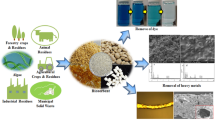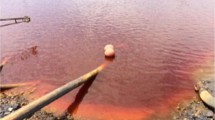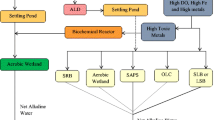Abstract
The co-treatment of AMD with other common liquid wastes is a promising synergistic approach, fusing characteristics of active and passive AMD treatment for a sustainable remediation strategy. This paper discusses existing literature on AMD co-treatment approaches, focusing on factors that influence the feasibility of co-treatment, such as mixing proportions, microbiological elements, reactor design, and mixed-water chemistry. Finally, this paper highlights future possibilities, drawing attention to prospects that require exploration.
Zusammenfassung
Die gemeinsame Behandlung saurer Grubenwässer mit anderen gängigen Flüssigabfällen ist als nachhaltige Sanierungsstrategie ein vielversprechender synergetischer Ansatz zur passiven und aktiven Behandlung saurer Grubenwässer. Diese Arbeit erörtert vorhandene Literatur mit Mitbehandlungsansätzen für saure Grubenwässer mit dem Schwerpunkt auf Faktoren wie Mischungsverhältnisse, mikrobiologische Elemente, Reaktorkonstruktion und Mischwasserchemie, die die Durchführbarkeit der gemeinsamen Behandlung beeinflussen. Abschließend zeigt die Arbeit zukünftige Möglichkeiten unter Hinweis auf Chancen und Risiken die weiteren Untersuchungen erfordern auf.
Resumen
El tratamiento conjunto de la AMD con otros desechos líquidos comunes es un enfoque sinérgico prometedor, que fusiona las características del tratamiento de AMD activo y pasivo para una estrategia de remediación sostenible. Este artículo analiza la literatura existente sobre los enfoques de tratamiento conjunto de AMD, enfocándose en factores que influyen en la viabilidad del tratamiento conjunto, como las proporciones de mezcla, los elementos microbiológicos, el diseño del reactor y la química de agua mixta. Finalmente, este documento destaca las posibilidades futuras, llamando la atención sobre las perspectivas que requieren exploración.
抽象
酸性矿井废水(AMD)与其它常见液体废物的协同处理方法具有发展前景,它有望融合AMD主动与被动处理的特点而成为可持续性修复策略。讨论了现有关于AMD协同处理方法的文献,重点关注了影响协同处理可行性的因素,如混合比例、微生物种类、反应器设计和混合水化学特征。最后,突出了协同处理技术的发展前景与研究方向。
Similar content being viewed by others
References
Abril G, Frankignoulle M (2001) Nitrogen–alkalinity interactions in the highly polluted Scheldt basin (Belgium). Water Res 35:844–850
Akcil A, Koldas S (2006) Acid Mine Drainage (AMD): causes, treatment and case studies. J Clean Prod 14:1139–1145
Al-Qodah Z (2006) Biosorption of heavy metal ions from aqueous solutions by activated sludge. Desalination 196:164–176
Azapagic A (2004) Developing a framework for sustainable development indicators for the mining and minerals industry. J Clean Prod 12:639–662
Bekmezci OK, Ucar D, Kaksonen AH, Sahinkaya E (2011) Sulfidogenic biotreatment of synthetic acid mine drainage and sulfide oxidation in anaerobic baffled reactor. J Hazard Mater 189:670–676
Buitrón G, Carvajal C (2010) Biohydrogen production from Tequila vinasses in an anaerobic sequencing batch reactor: effect of initial substrate concentration, temperature and hydraulic retention time. Bioresour Technol 101:9071–9077
Caravelli AH, Contreras EM, Zaritzky NE (2010) Phosphorous removal in batch systems using ferric chloride in the presence of activated sludges. J Hazard Mater 177:199–208
Chang IS, Shin PK, Kim BH (2000) Biological treatment of acid mine drainage under sulphate-reducing conditions with solid waste materials as substrate. Water Res 34:1269–1277
Chang W-C, Hsu C-H, Chiang S-M, Su M-C (2007) Equilibrium and kinetics of metal biosorption by sludge from a biological nutrient removal system. Environ Technol 28:453–462
Chipasa KB (2003) Accumulation and fate of selected heavy metals in a biological wastewater treatment system. Waste Manag 23:135–143
Choi E, Rim JM (1991) Competition and inhibition of sulfate reducers and methane producers in anaerobic treatment. Water Sci Technol 23:1259–1264
Crane RS, Barton P, Cartmell E, Coulon F, Hillis P, Judd SJ, Santos A, Stephenson T, Lester JN (2010) Fate and behaviour of copper and zinc in secondary biological wastewater treatment processes: I Evaluation of biomass adsorption capacity. Environ Technol 31:705–723
Demin OA, Dudeney AWL (2003) Nitrification in constructed wetlands treating ochreous mine water. Mine Water Environ 22:15–21
Deng D, Lin L-S (2013) Two-stage combined treatment of acid mine drainage and municipal wastewater. Water Sci Technol 67:1000–1007
Deng D, Weidhaas JL, Lin L-S (2016) Kinetics and microbial ecology of batch sulfidogenic bioreactors for co-treatment of municipal wastewater and acid mine drainage. J Hazard Mater 305:200–208
García-Muñoz P, Pliego G, Zazo JA, Munoz M, de Pedro ZM, Bahamonde A, Casas JA (2017) Treatment of hospital wastewater through the CWPO-Photoassisted process catalyzed by ilmenite. J Environ Chem Eng 5:4337–4343
Hamjinda NS, Chiemchaisri W, Watanabe T, Honda R, Chiemchaisri C (2018) Toxicological assessment of hospital wastewater in different treatment processes. Environ Sci Pollut Res 25:7271–7279
He C, Zhang T, Vidic RD (2013) Use of abandoned mine drainage for the development of unconventional gas resources. Disruptive Sci Technol 1:169–176
He C, Li M, Liu W, Barbot E, Vidic RD (2014a) Kinetics and equilibrium of barium and strontium sulfate formation in Marcellus Shale flowback water. J Environ Eng 140:B4014001
He C, Wang X, Liu W, Barbot E, Vidic RD (2014b) Microfiltration in recycling of Marcellus Shale flowback water: solids removal and potential fouling of polymeric microfiltration membranes. J Memb Sci 462:88–95
He C, Zhang T, Zheng X, Li Y, Vidic RD (2014c) Management of Marcellus Shale produced water in Pennsylvania: a review of current strategies and perspectives. Energy Technol 2:968–976
He C, Zhang T, Vidic RD (2016) Co-treatment of abandoned mine drainage and Marcellus shale flowback water for use in hydraulic fracturing. Water Res 104:425–431
Hedin RS, Nairn RW (1993) Contaminant removal capabilities of wetlands constructed to treat coal mine drainage. In: Moshiri GA (ed) Constructed wetlands for water quality improvement. Lewis Publ, Boca Raton, pp 187–195
Hickenbottom KL, Hancock NT, Hutchings NR, Appleton EW, Beaudry EG, Xu P, Cath TY (2013) Forward osmosis treatment of drilling mud and fracturing wastewater from oil and gas operations. Desalination 312:60–66
Hughes TA, Gray NF (2012) Acute and chronic toxicity of acid mine drainage to the activated sludge process. Mine Water Environ 31:40–52
Hughes TA, Gray NF (2013a) Removal of metals and acidity from acid mine drainage using municipal wastewater and activated sludge. Mine Water Environ 32:170–184
Hughes TA, Gray NF (2013b) Co-treatment of acid mine drainage with municipal wastewater: performance evaluation. Environ Sci Pollut Res 20:7863–7877
Janssen AJH, Ruitenberg R, Buisman CJN (2001) Industrial applications of new sulphur biotechnology. Water Sci Technol 44:85–90
Johnson DB, Hallberg KB (2005) Acid mine drainage remediation options: a review. Sci Total Environ 338:3–14
Johnson KL, Younger PL (2006) The co-treatment of sewage and mine waters in aerobic wetlands. Eng Geol 85:53–61
Joseph JM, Shay DE (1952) Viability of Escherichia coli in acid mine waters. Am J Public Health N 42:795–800
Kaksonen AH, Franzmann PD, Puhakka JA (2004) Effects of hydraulic retention time and sulfide toxicity on ethanol and acetate oxidation in sulfate-reducing metal-precipitating fluidized-bed reactor. Biotechnol Bioeng 86:332–343
Kefeni KK, Msagati TM, Mamba BB (2015) Synthesis and characterization of magnetic nanoparticles and study their removal capacity of metals from acid mine drainage. Chem Eng J 276:222–231
Kerr RA (2010) Natural gas from shale bursts onto the scene. Science 328:1624–1626. https://doi.org/10.1126/science.328.5986.1624
Kim M-S, Cha J, Kim D-H (2013) Fermentative biohydrogen production from solid wastes. In: Biohydrogen, Elsevier, pp 259–283
Klein R, Schlömann M, Zeng Y, Wacker B, Glombitza F, Janneck E, Muhling M (2013) Impact of the hydraulic retention time on the performance of a sulfidogenic bioreactor. Adv Mat Res 825:392–395
Kondash AJ, Warner NR, Lahav O, Vengosh A (2013) Radium and barium removal through blending hydraulic fracturing fluids with acid mine drainage. Environ Sci Technol 48:1334–1342
Kumar RN, McCullough CD, Lund MA (2011a) How does storage affect the quality and quantity of organic carbon in sewage for use in the bioremediation of acidic mine waters? Ecol Eng 37:1205–1213
Kumar RN, McCullough CD, Lund MA, Newport M (2011b) Sourcing organic materials for pit lake bioremediation in remote mining regions. Mine Water Environ 30:296–301
Lee C, Fletcher TD, Sun G (2009) Nitrogen removal in constructed wetland systems. Eng Life Sci 9:11–22
Liamleam W, Annachhatre AP (2007) Electron donors for biological sulfate reduction. Biotechnol Adv 25:452–463
Liu Q, Zhou Y, Chen L, Zheng X (2010) Application of MBR for hospital wastewater treatment in China. Desalination 250:605–608
Lovley DR, Phillips EJP (1986a) Availability of ferric iron for microbial reduction in bottom sediments of the freshwater tidal Potomac River. Appl Environ Microbiol 52:751–757
Lovley DR, Phillips EJP (1986b) Organic matter mineralization with reduction of ferric iron in anaerobic sediments. Appl Environ Microbiol 51:683–689
Lu X, Zhen G, Ni J, Hojo T, Kubota K, Li YY (2016) Effect of influent COD/SO42− ratios on biodegradation behaviors of starch wastewater in an upflow anaerobic sludge blanket (UASB) reactor. Bioresour Technol 214:175–183
McCullough CD (2008) Approaches to remediation of acid mine drainage water in pit lakes. Int J Min Reclam Env 22:105–119
McCullough CD, Lund MA (2011) Bioremediation of acidic and metalliferous drainage (AMD) through organic carbon amendment by municipal sewage and green waste. J Environ Manage 92:2419–2426
McCullough CD, Lund MA, May JM (2006) Microcosm testing of municipal sewage and green waste for full-scale remediation of an acid coal pit lake, in semi-arid tropical Australia. In: Barnhisel RI (ed), Proc, 7th International Conf on Acid Rock Drainage, St. Louis, pp 1177–1197
McCullough CD, Lund MA, May JM (2008a) Field-scale demonstration of the potential for sewage to remediate acidic mine waters. Mine Water Environ 27:31–39
McCullough CD, Lund MA, May JM (2008b) Treating acidity in coal pit lakes using sewage and green waste: microcosm and field scale trials at the Collinsville Coal Project (Queensland), Citeseer
Menezes J, Silva RA, Arce IS, Schneider IAH (2009) Production of a poly-ferric sulphate chemical coagulant by selective precipitation of iron from acidic coal mine drainage. Mine Water Environ 28:311
Meng F, Shi B, Yang F, Zhang H (2007) Effect of hydraulic retention time on membrane fouling and biomass characteristics in submerged membrane bioreactors. Bioprocess Biosyst Eng 30:359–367
Mesdaghinia AR, Naddafi K, Nabizadeh R, Saeedi R, Zamanzadeh M (2009) Wastewater characteristics and appropriate method for wastewater management in the hospitals. Iran J Public Health 38:34–40
Metcalf E, Eddy M (2014) Wastewater engineering: treatment and resource recovery. Mic Graw-Hill, USA
Mulopo J (2016) Pilot scale assessment of the continuous biological sulphate removal from coal acid mine effluent using grass cutting as carbon and energy sources. J Water Process Eng 11:104–109
Munoz M, Garcia-Muñoz P, Pliego G, de Pedro ZM, Zazo JA, Casas JA, Rodriguez JJ (2016) Application of intensified Fenton oxidation to the treatment of hospital wastewater: kinetics, ecotoxicity and disinfection. J Environ Chem Eng 4:4107–4112
Neculita C-M, Zagury GJ, Bussière B (2007) Passive treatment of acid mine drainage in bioreactors using sulfate-reducing bacteria. J Environ Qual 36:1–16
Oktem YA, Ince O, Sallis P, Donnelly T, Ince BK (2008) Anaerobic treatment of a chemical synthesis-based pharmaceutical wastewater in a hybrid upflow anaerobic sludge blanket reactor. Bioresour Technol 99:1089–1096
Paikaray S (2015) Arsenic geochemistry of acid mine drainage. Mine Water Environ 34:181–196
Pambrun V, Marquot A, Racault Y (2008) Characterization of the toxic effects of cadmium and 3.5-dichlorophenol on nitrifying activity and mortality in biologically activated sludge systems—effect of low temperature. Environ Sci Pollut Res 15:592–599
Pearson FH, Nesbitt JB (1974) Acid mine drainage as a chemical coagulant for treatment of municipal wastewater. Proc, 5th Symp Coal Mine Drainage Research, Lousville, pp 181–191
Peer RAM, LaBar JA, Winfrey BK, Nair RW, Llanos Lopez FS, Strosnider WHJ (2015) Removal of less commonly addressed metals via passive cotreatment. J Environ Qual 44:704–710
Rao SR, Gehr R, Riendeau M, Lu D, Finch JA (1992) Acid mine drainage as a coagulant. Miner Eng 5:1011–1020
Rockhold ML, Yarwood RR, Niemet MR, Bottomley PJ, Selker JS (2002) Considerations for modeling bacterial-induced changes in hydraulic properties of variably saturated porous media. Adv Water Resour 25:477–495
Roetman ET (1932) The sterilization of sewage by acid mine water. MS Thesis, West Virginia Univ
Rose PD, Boshoff GA, van Hille RP, Wallace LCM, Dunn KM, Duncan JR (1998) An integrated algal sulphate reducing high rate ponding process for the treatment of acid mine drainage wastewaters. Biodegradation 9:247–257
Sandström Å, Mattsson E (2001) Bacterial ferrous iron oxidation of acid mine drainage as pre-treatment for subsequent metal recovery. Int J Miner Process 62:309–320
Santos A, Judd S (2010) The fate of metals in wastewater treated by the activated sludge process and membrane bioreactors: a brief review. J Environ Monit 12:110–118
Santos S, Machado R, Correia MJN, Carvalho JR (2004) Treatment of acid mining waters. Miner Eng 17:225–232
Sivakumar D (2014) Role of low cost agro-based adsorbent to treat hospital wastewater. Pollut Res 2014g 33:573–576
Smyntek PM, Chastel J, Peer RAM, Anthony E, McCloskey J, Bach E, Wagner RC, Bandstra JZ, Strosnider WHJ (2018) Assessment of sulphate and iron reduction rates during reactor start-up for passive anaerobic co-treatment of acid mine drainage and sewage. Geochem Explor Env Anal 18:76–84
Strosnider WHJ, Nairn RW (2010) Effective passive treatment of high-strength acid mine drainage and raw municipal wastewater in Potosí, Bolivia using simple mutual incubations and limestone. J Geochem Explor 105:34–42
Strosnider WHJ, Winfrey BK, Nairn RW (2011a) Novel passive co-treatment of acid mine drainage and municipal wastewater. J Environ Qual 40:206–213. https://doi.org/10.2134/jeq2010.0176
Strosnider WHJ, Winfrey BK, Nairn RW (2011b) Biochemical oxygen demand and nutrient processing in a novel multi-stage raw municipal wastewater and acid mine drainage passive co-treatment system. Water Res 45:1079–1086. https://doi.org/10.1016/j.watres.2010.10.026
Strosnider WHJ, Winfrey BK, Nairn RW (2011c) Alkalinity generation in a novel multi-stage high-strength acid mine drainage and municipal wastewater passive co-treatment system. Mine Water Environ 30:47–53
Strosnider WHJ, Nairn RW, Peer RAM, Winfrey BK (2013a) Passive co-treatment of Zn-rich acid mine drainage and raw municipal wastewater. J Geochem Explor 125:110–116. https://doi.org/10.1016/j.gexplo.2012.11.015
Strosnider WHJ, Winfrey BK, Peer RAM, Nairn RW (2013b) Passive co-treatment of acid mine drainage and sewage: anaerobic incubation reveals a regeneration technique and further treatment possibilities. Ecol Eng 61:268–273. https://doi.org/10.1016/j.ecoleng.2013.09.037
Tsukamoto TK, Killion HA, Miller GC (2004) Column experiments for microbiological treatment of acid mine drainage: low-temperature, low-pH and matrix investigations. Water Res 38:1405–1418
Utgikar VP, Harmon SM, Chaudhary N, Tabak HH, Govind R, Haines JR (2002) Inhibition of sulfate-reducing bacteria by metal sulfide formation in bioremediation of acid mine drainage. Environ Toxicol 17:40–48
Van Bodegom PM, Scholten JCM, Stams AJM (2004) Direct inhibition of methanogenesis by ferric iron. FEMS Microbiol Ecol 49:261–268
Van Hille RP, Boshoff GA, Rose PD, Duncan JR (1999) A continuous process for the biological treatment of heavy metal contaminated acid mine water. Resour Conserv Recycl 27:157–167
Varela AR, André S, Nunes OC, Manaia CM (2014) Insights into the relationship between antimicrobial residues and bacterial populations in a hospital-urban wastewater treatment plant system. Water Res 54:327–336
Wei X, Viadero RC Jr, Bhojappa S (2008) Phosphorus removal by acid mine drainage sludge from secondary effluents of municipal wastewater treatment plants. Water Res 42:3275–3284
Winfrey BK, Strosnider WHJ, Nairn RW, Strevett KA (2010) Highly effective reduction of fecal indicator bacteria counts in an ecologically engineered municipal wastewater and acid mine drainage passive co-treatment system. Ecol Eng 36:1620–1626. https://doi.org/10.1016/j.ecoleng.2010.06.025
Younger PL, Henderson R (2014) Synergistic wetland treatment of sewage and mine water: pollutant removal performance of the first full-scale system. Water Res 55:74–82
Younger PL, Banwart SA, Hedin RS (2002) Mine water: hydrology, pollution, remediation. Springer Science & Business Media, Berlin
Zhang M (2011) Adsorption study of Pb(II), Cu (II) and Zn (II) from simulated acid mine drainage using dairy manure compost. Chem Eng J 172:361–368
Zhang T (2015) Origin and fate of radium in flowback and produced water from marcellus shale gas exploration. Univ of Pittsburgh, USA, PhD diss
Zhang L, Keller J, Yuan Z (2009) Inhibition of sulfate-reducing and methanogenic activities of anaerobic sewer biofilms by ferric iron dosing. Water Res 43:4123–4132
Zhang T, Gregory K, Hammack RW, Vidic RD (2014) Co-precipitation of radium with barium and strontium sulfate and its impact on the fate of radium during treatment of produced water from unconventional gas extraction. Environ Sci Technol 48:4596–4603
Zheng X (2013) Optimization of treatment options to enable the use of abandoned mine drainage (AMD) for hydraulic fracturing in marcellus shale. MS Thesis, Univ of Pittsburgh, Pittsburgh
Zipper CE, Skousen JG (2010) Influent water quality affects performance of passive treatment systems for acid mine drainage. Mine Water Environ 29:135–143
Acknowledgements
The first author would like to thank the support from the National Research Foundation, grant reference no: TTK180412319899.
Author information
Authors and Affiliations
Corresponding author
Rights and permissions
About this article
Cite this article
Makhathini, T.P., Mulopo, J. & Bakare, B.F. Possibilities for Acid Mine Drainage Co-treatment with Other Waste Streams: A Review. Mine Water Environ 39, 13–26 (2020). https://doi.org/10.1007/s10230-020-00659-w
Received:
Accepted:
Published:
Issue Date:
DOI: https://doi.org/10.1007/s10230-020-00659-w




